Bordeaux 2015 from bottle, part 2
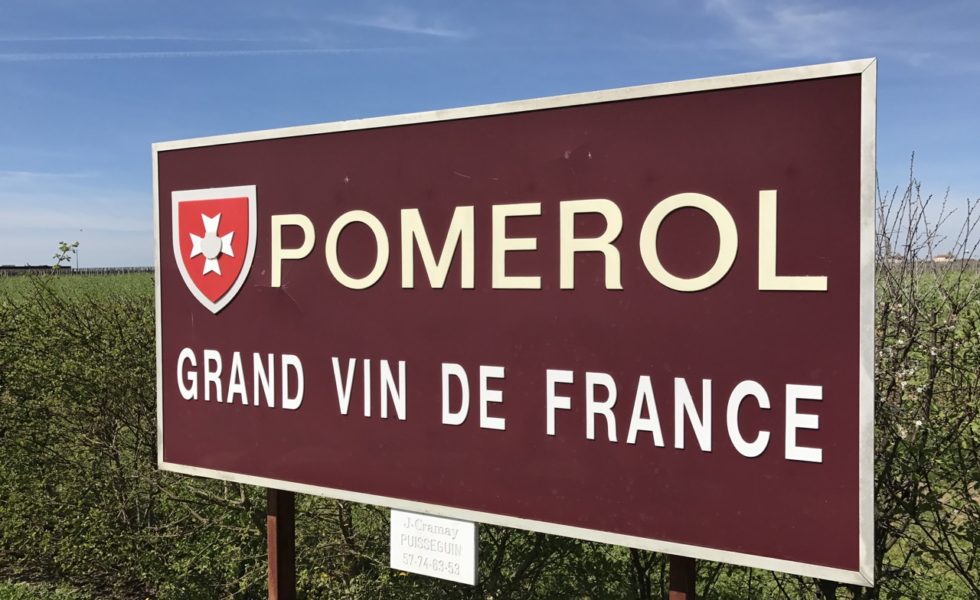
Pomerol isn’t just about the stars:
Update with more tasting notes!
By Panos Kakaviatos for wine-chronicles.com
11 January 2018 / 11 March
Just an update folks from this January post … Just a few more tasting notes directly below, in alphabetical order. Proving again how good Pomerol is in 2015.
UPDATED TEXT (MARCH 2018)
Château Le Bon Pasteur: What can I say? This is a modern style in a very good sense as it exudes opulence and even a heady quality, but it is balanced without drying on the finish (as can be in some other vintages). Basically, a delicious wine with a certain serious density for the longer run. Bravo! 93/100
Château la Cabanne: I like the fresh, ripe fruit aspects from this wine, which is tasty and medium bodied. But the finish is just a tad fleeting. At this price point, once can do better. 88/100
Château Clinet: I am perplexed here, as I think I liked this wine more from barrel with a score range between 92 and 94. The slight hardness seems more pronounced from bottle, with a certain – and this is positive – serious precision. There is power, too, reminding me a bit of some of the rather “armored” Moueix wines in this vintage. I would buy a six pack and forget in the cellar, as the baby fat from barrel is now gone, leaving behind quite a bit of structure. Wait n’ see. 92/100
Château Gazin: My initial reaction, when tasting at the UGCB in New York in January this year? Just terrific. Really, the aromatics are gorgeous, with deep violet floral aspects as well as dark ripe fruit. The mid palate is juicy yet dense. Sure, there is some oak derivation but not the type that will overcome the fruit over time. At least I am betting on the positive side, here, and go out on a (bit of a) limb perhaps with a very high score. Perhaps also because the price is not as high as some other prestigious neighbors so this constitutes a “relative bargain” for the already expensive appellation. A blend of 95% Merlot and 5% Cabernet Franc, and about 14.5% alcohol. 96/100.
Château La Pointe: Hats off to consultant Hubert de Boüard and general manager Eric Monneret, whom I had met when he was (a while back) at Château Raymond-Lafon in Sauternes. Their work to fine tune this estate has paid dividends reaching a sort of apotheosis in the 2015 vintage, perhaps the best I can recall, this blend of 85% Merlot and 15% Cabernet Franc clocking in at about 14.5% alcohol. A pure pleasure to drink: at once rich, savory, juicy and just very good. An example of buying “petits châteaux dans un grand millésime” … Worth buying for anyone seeking quality Pomerol for a moderate price. 92/100
EARLIER TEXT
Since I already had covered much of the Médoc last month, here, where Margaux shined brightest, now we turn mainly to the Right Bank. As expected from barrel tastings, the star of the Right Bank for 2015 is confirmed: Pomerol.
In tastings organized at individual estates, at the Libourne offices of pioneering Pomerol producer Établissements Jean-Pierre Moueix, and at Château de Pressac in Saint Emilion, where I tasted many wines whose estates are members of the Grand Cercle, I am convinced that savvy consumers can find economically priced 2015s from Pomerol, relatively speaking, as well as divas whose prices are scraping ever higher skies.
Of course the choice is somewhat limited with 150 estates – packed into just under 800 hectares in an area roughly three kilometers wide by four long – but that’s my work for you, dear reader: picking out excellent price/quality ratios, even from this cream-of-the-Bordeaux-crop appellation ?. Of course my notes include the stars, as well.
Long considered a sub appellation of Saint Emilion, Pomerol was granted independent status only in the early 20th century. The gently rolling plateau of Pomerol – 19 miles northeast of Bordeaux and two miles from the city of Libourne – slopes towards the Isle river valley and its confluence with the Dordogne. Although soils vary (not all Pomerol is created equal to be sure), you can find less expensive Pomerol that is being made better than ever before, according to my experience in tasting some of the less heralded estates over the last 10 years or so.
Indeed, trade representatives notice as well: “The less expensive brands work especially well for restaurants, explains Stephan Maure of the Vino Strada bistro in Strasbourg, France. “They bear the name of Pomerol and convey the refinement of the appellation, but do not cost an arm and a leg,” he stressed.
Rest assured that Bordeaux 2015 from bottle features many excellent Right Bank wines outside of Pomerol, from Saint Emilion to be sure, but also excellent wines from satellite appellations, notably Fronsac, which rather kicked ass in 2015. I will get to these in Part 3, focusing on Saint Emilion and many satellite appellations.
Part 4 will be dedicated to the Graves region, red and white, and Part 5 will focus on Sauternes and Barsac.
Later this month, in New York City and in Washington D.C., I will taste more Saint Emilion and Pomerol wines at the UGCB tour tastings, and will update this page, with a few more Pomerols, so be ready for an update at the end of January, along with Parts 3, 4 and 5.
For now, without further ado, let’s get to the tasting notes, starting with my favorite 2015 Right Bank appellation. As usual, wines I liked in particular are in bold. Even more are red and bold. And if underlined as well? Wine nirvana!
Pomerol
Tasting at the offices of Moueix in Libourne
Château Chantalouette – Described as “charming, round, elegant, and approachable from a young age” in literature from the Moueix, this is in fact the second wine of Château de Sales. Owned by the same family for over five centuries, the 116-acre estate is the largest in the appellation and boasts the only “true castle” of Pomerol. The estate does horse-ploughing and hand-harvesting, and traditional racking and light egg white fining. Chantalouette is named after one of the larger parcels constituting the vineyard of Château de Sales. At 14% alcohol, I like the nose. This is tasty and even savory actually. At first a bit firm, but it opens up with time. Not very long on the finish but a decent price. 88/100
Château Plince –Planted on dark sand with an iron-rich subsoil, Château Plince produces a “classic” Pomerol with fine fruit, depth and concentration typical of the appellation. At just over 21 acres, it is made up of one block and counts Châteaux Nenin and La Pointe as its neighbors. Under the same ownership for at least four generations, and represented by Moueix, the vineyard is tended traditionally and undergoes leaf-thinning and green harvests as needed. Aging in about 1/3 new French oak barrels. The 2015 conveys robust, sweet fruit and it is lovely for not being super ripe, but rather pleasingly ripe and rich. A bit of roasted paprika and mint freshen up the profile and at this very early stage the nearly 30% Cabernet Franc (the rest is Merlot) seems more pronounced than the Merlot. 14% alcohol. 90/100
Château Lafleur Gazin – Situated on the northern edge of the plateau of Pomerol, nestled between Château Gazin and Château La Fleur-Pétrus, this wine has been produced by Ets. Jean-Pierre Moueix since 1976 for the Borderie family, owners since 1930. The 85% Merlot comes from vines averaging 30 years of age, planted on gravel and clay. The rest is Cabernet Franc, planted on silt soils. According to the Moueix brochure, the wine is typically “eminently approachable, even in its youth,” as a “delightful expression of the lighter style of Pomerol wines”. Indeed, I am accustomed to more floral and elegant styles coming from this wine, but it is not really so in 2015. Certainly the aromatics are deeper than those at Château Plince, assessed just before, at the Moueix tasting, and the palate shows character and density. And, at 14.5% alcohol, it is not as heady as one could expect. But overall, I get a sense of some austere tannins, with even a bit of rusticity. In that sense, a mild let down. 91/100
Château La Grave – A blend of 85% Merlot and 15% Cabernet Franc, Château La Grave dates back to the 19th century, when it was owned by the Trigant de Boisset family (acquired by Christian Moueix in 1971). The vines lie on the western side of the plateau of Pomerol. Like the name, the terroir of Château La Grave is almost pure gravel, marking the beginning of a mile-long gravelly strip that continues into Saint-Émilion, passing through Château Cheval Blanc before ending at Château Figeac. Here we have a wine that constitutes a relative bargain for the generally expensive appellation of Pomerol. Like Lafleur Gazin, tasted just before, this wine is 14.5% alcohol as well, but the tannins are smoother and the wine conveys a greater sense of “Pomerol opulence” plus noticeable tannic power. As for the nose, it comes across more like a Pauillac, with pencil lead coming to the fore. Quite serious wine, but with sumptuousness, too. Very well done! 93/100
Château Bourgneuf – Owned by the Vayron family since 1821, this vineyard lies in the heart of Pomerol’s most prestigious terroirs, with Château Trotanoy as its neighbor. Formed by a sloping plot, the west-facing vineyard enjoys ideal sun exposure – indeed a very warm spot in Pomerol. The wine is a blend of 90% Merlot and 10% Cabernet Franc. The vines have an average age of 40 years, planted on gravelly clay enhanced by an iron-rich subsoil. Aging in 35% new oak barrels. The wine conveys firm tannins and structure, but with opulence. What I like most is the nuance and the elegance so there is excellent aging potential. Nice! 92/100
Château Latour à Pomerol – This famous estate has eight hectares of vineyards characterized by soil diversity, which brings complexity to the wine: gravel and clay for a parcel next to the church of Pomerol and loam surrounding the château. Etablissements Jean-Pierre Moueix has farmed the vineyard since 1962. At 14.5% alcohol, the wine comes across gorgeously, with floral and graphite aromatics preceding a tannic, yet suave and velvety palate: indeed, the proverbial iron in a velvet glove. An excellent vintage for this estate! 95/100
Château Certan de May – At about 5.5 hectares of vines on Pomerol’s prized central plateau, the estate is surrounded by illustrious neighbors such as Vieux Château Certan and La Fleur-Pétrus. I often love this estate, but not quite as much in 2015. I was expecting more from the vineyard’s soil composition: a combination of clay and gravel that can bring together power and elegance, structure and freshness. Tasted just after Latour à Pomerol, and also 14.5% alcohol, the nose is not quite as inspired, coming across just a bit candied. Prettier perhaps, and delivering quite a bit of red berry fun, the 2015 does not convey as much gravitas as I was expecting. 92/100
Château Hosanna – Prior to its purchase by Ets. Jean-Pierre Moueix in 1999, Hosanna was known as Château Certan Giraud, considered one of the premier crus of Pomerol since the 1950’s. I recall enjoying that wine throughout the 1990s. The vineyard enjoys a terroir of red gravel and clay on the “crasse de fer” which is known for producing wines of great elegance, complexity, and power. Old Cabernet Franc vines, which make up 30% of the blend (the rest is Merlot) contribute complexity to the cru. Now in 2015, the ripening achieved a whopping 15% alcohol and thankfully it is not so much heady as quite tannic, like a “masculine Pauillac” and the old vine Cabernet Franc brings forth almost cigar box like aromatics. Quite a serious wine and needs at least 10 years of cellaring before it would be ready to properly enjoy. We shall see. 94/100
Château La Fleur Petrus – A fabulous terroir of nearly 46 acres, La Fleur-Pétrus is composed predominantly of Merlot, which lends silkiness and generosity to the wine, while a small percentage of Cabernet Franc contributes rigor and complexity, according to the official brochure. I buy that completely. The vineyard is made up of three parcels on the plateau of Pomerol with altitudes averaging 33 to 38 meters above sea level. The pebbly soils from the northern parcel yield a wine of elegance. The center plot, known for its summer heat (the area is called Tropchaud or “too hot” in French), produces wine of suppleness. Wine from the southern parcel is particularly velvety, dense and structured. Blended, these three singular terroirs with nuanced and complementary characteristics produce a generous, expressive wine, year in and year out. 2015 was particularly grand for this estate, as the wine just bottled exudes gorgeous floral elegance, with the weight and vigor of Latour à Pomerol, which also did very well in 2015. The 15% alcohol is very well integrated although it has a bit of headiness on the finish, and lacks the tantalizing balance of the other Pomerol with Petrus in its name … 96/100
Château Trotanoy – Purchased by Jean-Pierre Moueix in 1953, Château Trotanoy has long been considered a top terroir. It has soil that is a very dense mixture of clay and gravel, which tends to solidify as it dries out after rain to an almost concrete-like hardness: hence the name “Trotanoy,” or, in other words, “too wearisome” to cultivate. Often considered the top wine of the Moueix stable for aging potential, it often has a profound and richly-concentrated profile, blending 90% Merlot and 10% Cabernet Franc, whose vines average 35 years of age. The 2015? Like an armored car. The nose is very promising, deep and rich, with violet and dark fruit, and a bit heady, with 15% alcohol. The palate is dense and layered. The finish however is marked by very powerful tannins that yell: “Don’t touch me for another 20 years.” 95/100 (although you will need to wait to truly get to that score and perhaps more)
Tastings at individual estates (no particular order)
Petrus – The the top wine of the vintage? At the very least, it gives Château Margaux a run for its money. Tasting with winemaking director Olivier Berrouet, along with fellow wine writers Jane Anson and Yohan Castaing, it is easy to marvel at the freshness, burgeoning complexity and density that this wine delivers. The 3.5 pH was low to match the nearly 15% alcohol. Indeed, we spoke of a “great level of acidity,” perhaps owing to the fact that 2015 did not have a “drought issue,” as in 2016, Olivier remarked, so there is fine balance, as August rainfall thankfully slowed down maturity. “We picked at a good ripeness level,” Berrouet said. Indeed, 2010, which to me is less subtle, for example, had a higher pH at 3.6. Readers know that this fabled estate benefits from a unique soil of blue-clay over a band of sand, rich in iron deposits known as the crasse de fer. Of only 20 hectares (50 acres), Petrus owns over half of this type of soil that tends to yield powerful yet elegant wines. The result is a wine like the 2015: burgeoning aromatic complexity of black olive, ripe and opulent fruit and fine dark chocolate. The palate conveys density, length and lift to the finish. No hint of drying, a bit of which I detected by comparison at other properties, even at the great Vieux Château Certan, tasted just before. Pristine balance and only 50% new oak, which is very important to retain sap driven juiciness especially when alcohol levels approach 15% (such juiciness is almost totally effaced by wines like Pavie in Saint Emilion, to take a noteworthy example). 100/100
Château Lafleur – Known justifiably as one of the world’s finest wines – in the same league as Petrus – the vineyards of Lafleur benefit more from a gravel-rich terroir that adjoins La Fleur-Pétrus. They are deep and enriched by potassium and iron. Only natural fertilisers are used and yields are painfully low. Lafleur typically blends Merlot (50%) with Cabernet Franc (50%) and is aged in small oak barrels, this year only 20% new oak, for 18 months. The low measure of new oak could be judicious insofar as the near 15% alcohol would have drawn in more new oak tannin than necessary during aging. The result? Quite rich and flavorful, with a fresh and sap-driven opulence, all very refined. Sure, there is a (gorgeous) roasted fruit aspect coming from the warm gravely soils. But the 50% Cabernet Franc lends needed structure as well as freshness. The overall impression is a wine of substantial weight but not hard tannic extraction, which seemed to affect some of the Moueix wines in 2015, also high in alcohol. Compare for example Trotanoy, which is like an armored car – an impressive armored car to be sure – and you notice greater elegance and refinement at Lafleur, even if Lafleur has copious, dense and “laying over” tannins to be sure. Just a note with regard to Petrus, as I tasted both on the same day: I give the edge to Petrus, which seems to have greater potential for complexity. Perhaps the cooler blue clay served the vintage better? Not sure. But both Lafleur and Petrus are fantastic – and incredibly expensive. I cannot afford either, but if you can, do not hesitate as 2015 is a particularly great vintage for both estates. 99/100
Cellar master Omri Ram on “the numbers” that shouldn’t matter so much …
Pensées de Lafleur – Made up of a .68 hectares diagonal plot of land that crosses the vineyard with more clay – as most of the vineyard is gravel. The wine is simply gorgeous, like a bouquet of flowers that precedes such fine depth and ripe, dark fruit. Less than 3,000 bottles were made. And only 20 percent new oak. This is as far and away as you get from the 100% new oak driven over extracted monsters that can be (still) found on the Right Bank… As I sipped more, I could not help but exclaim: “What freshness, what succulence!” The blend is 55% Merlot and the rest Cabernet Franc. This may be the highest score I have ever given to a second wine… 96/100
Château La Conseillante – Tasted as the final wine of a 20-vintage vertical at the estate on 1 December 2017, this shows a very ripe and deep nose, somewhat like the 2009 was back in about the same period for that vintage. There is some heaviness, with alcohol is 14.5% and pH at 3.65, but overall one cannot but adore a great density of fruit, and how the elements should come together over time in bottle to develop into a great wine. The words kept repeating themselves in my head: “profound” and “deep” and hence result in a very high score overall. 96/100
Vieux Château Certan – At 15% alcohol, this was very ripe and floral and spicy. Some vines over 80 years old lend depth to the wine. The youngest vines used are at least 20 years old in this blend of 19% Cabernet France, 1% Cabernet Sauvignon and the rest Merlot. Again the challenge to avoid jam was there: “This was the highest ever alcohol level that we can recall,” Thienpont said. The rather high 80 IPT index means tannins as well, but they are very supple tannins: smooth and round. Aging in 70% new oak. “It resembles a bit our 2009,” Guillaume said. Time in glass revealed more spicy and rich aspects almost like a Christmas cake. Now, it does not meet the level of greatness to me as the 2005 vintage, as I do get just a slight sense of drying, but overall, this is a great vintage of VCC. Guillaume remarked that the 2014 was “correct” which led me to ask: “What do you mean?” and he then simply answered: “You want to try it?” And we – I was with Jane Anson and Yohan Castaing – rather enthusiastically said “Yes.” 95/100
Vieux Château Certan 2014 – Boy am I glad to have purchased 6 bottles of this vintage. It is not merely “correct” I insisted … Same blend as in 2015, but the pH is 3.5 and one gets a sense of greater freshness even if the first comparative impression is one of a wine being a bit more edgy. Fine ripeness is there and with time in glass, there is sumptuous, as well. The tannins are present and there is power, but the overall impression is one of more blue than succulent ripe and black fruit more associated with the 2015. 94/100
La Gravette de Certan – This is the second wine of Vieux Château Certan, and in 2015 it comes across “nice and smooth.” The challenge, remarked Guillaume Thienpont was “not to make jam” in this vintage. Maintaining freshness with 14.5% alcohol was indeed a tightrope issue, as the pH was at 3.75 (at Petrus is was 3.5). I liked the freshness indeed, as the blend of 10% Cabernet Sauvignon, 15% Cabernet Franc and the rest Merlot did not come across heavy handed. There is a pleasing red berry aspect to the wine although one feels a bit of alcohol on the somewhat short finish. One-third of the harvest was used to make this second wine. 90/100
Château Nenin – This blend of 67 Merlot et 33 CF includes old vines up to 70 years old. The terroir faces Trotanoy on the plateau and the wine is getting better and better. Aged in 35 percent new oak, the wine exudes opulent fruit, and lovely freshness from the Cabernet Franc. Not nearly as impressive as the Evangile, tasted the day before, Nenin still shows why Pomerol was a superb appellation in 2015. Bottled in June, with 77 IPT, 3,72 pH, 14,3 alcohol. 92/100
Château Evangile – Wow. Just wow. What opulence, what focused ripe dark fruit and freshness, too, with loads of spicy fun. 14.5% alcohol? Not really felt, and this with 90% new oak. I really loved the 2016, but the 2015 is at least an equal from bottle. The finish is sexy and exciting and long, with the sense of balance following through. Weight and lift. Lifting weights? No, just pleasure. (97 pts.)
Tasting at the Grand Cercle
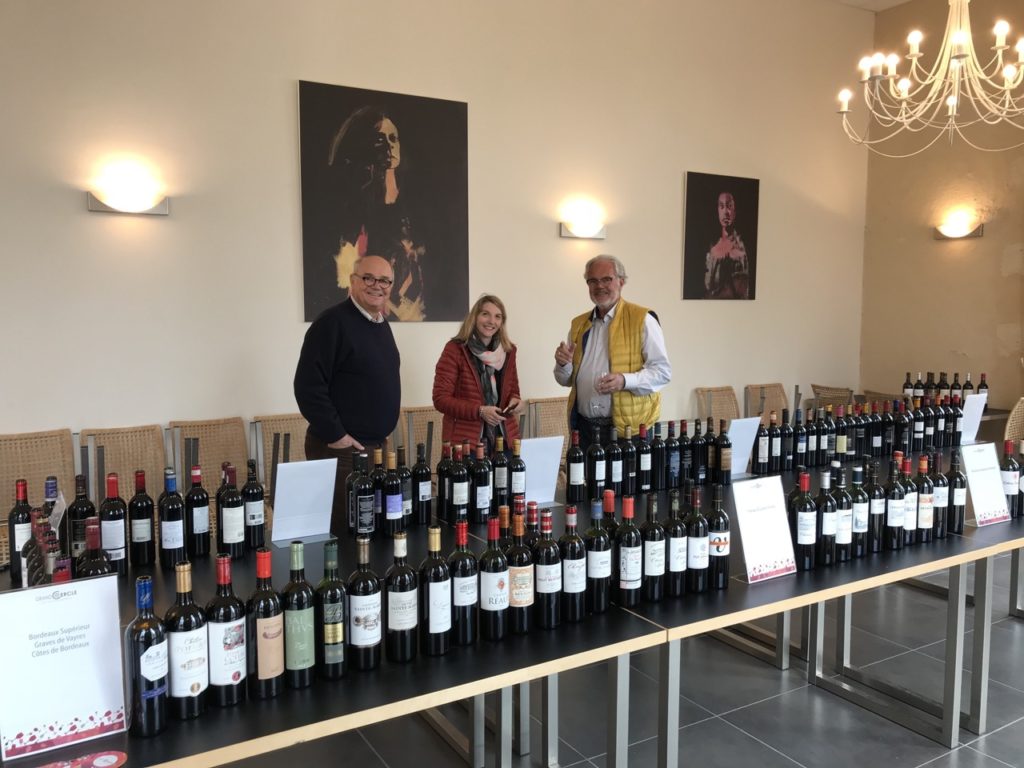
Tasting over 150 wines – all members of the Grand Cercle – at Château de Pressac with, left to right, Jean-François Quenin of Château de Pressac and Stéphanie Delécrin and Dr. Alain Raynaud of the Grand Cercle.
Château Le Clémence – Comes from a “patchwork” of terroirs that characterize Pomerol: red gravel soils, white gravel soils, sand on clay, blue clay. The six plots on three hectares are carefully tended and the wines are getting better each year. Although it comes across just a bit simple, I like the primary ripe fruit. Compared to some others tasted at the Grand Cercle tasting, it seems to have a bit more hard tannin, but there is much substance and density to the palate, so this is promising for a bit of cellar aging. 14.5% alcohol. 90
Château Feytit-Clinet – Although there is here a bit of a four square aspect, compared to, say, Bourgneuf, which I had tasted at the Grand Cercle and at the Moueix tasting, it does deliver the goods in a ripe and rather rich fashion. Interesting to note the terroir aspects here, as the vineyard likes lower on a slope as compared to Bourgneuf, while Trotanoy is higher than both. The vineyard covers 6.5 hectares and is made up of 90% Merlot and 10% Cabernet Franc, the average age of which is 30 years. The vines grow in gravelly, sandy soils and are cultivated using traditional techniques. 91
Château La Commanderie – This is rather stolid although with some edgy and perhaps too detectable oak-driven tannin. Tasted just after the preceding wines, it lacks the sumptuous nature of Bourgneuf and the linear focus of Feytit-Clinet. Still, the ripe fruit is there as is the density of the vintage. 89
Château Lecuyer – This blend of 90% Merlot and the rest Cabernet Franc comes from a small vineyard of 3 hectares than cover two types of soils: (1) gravel over clay on the plateau, not too far from the church. These soils tend towards generous and racy wines and (2) the bottom of the plateau that has sand over clay, that can result in lighter more elegant wines. My overall impression? A wine that is both flavorful and rich. It may lack the depth of, say, Bourgneuf, but it has a distinct fun factor on the rich mid palate. The finish is a tad austere but that means it just needs some bottle aging to smoothen out the tannins. Good job. 90
Château Mazeyres – This 25-hectare property, certified organic and converted to biodynamic viticulture since 2015, is darn good. Gravely, sandy and clay soils yield excellent wine for a fair price. While not exhibiting the same density of higher caliber Pomerol, the just-bottled 2015 vintage exhibits smooth succulence and fine depth. 91
Clos de la Vieille Eglise – Just 1.5 hectares, the vineyard consists of clay and gravel and the vines average 45 years old. New oak barrels are filled with the new vintage for malolactic fermentation. The same barrels will then be used for ageing approximately 20 months. The 30% of Cabernet Franc in the blend is meant to lend freshness and the majority is of course Merlot. This is OK, and – yes – there is a certain mentholated fresh aspect but overall a bit too straightforward and lacking nuance as compared to its peers. 88
Clos Vieux Taillefer – Tasted after the previous “Clos,” this wine conveys more warmth and pleasure, with impressive lingering length marked by ripe fruit. There is a minty freshness to the aftertaste that is nice as well. Very nice work! 90
Château Vray Croix de Gay – Since 2015, three parcels of vines that have begun conversion to organic growing and managed bio-dynamically. Alain Raynaud made this wine. It is at 14.5% alcohol, 85% Merlot and 15% Cabernet Franc. It conveys fine richness and depth and should reward your palate even this young but more so with 10+ years of cellaring. 91
 Wine Chronicles
Wine Chronicles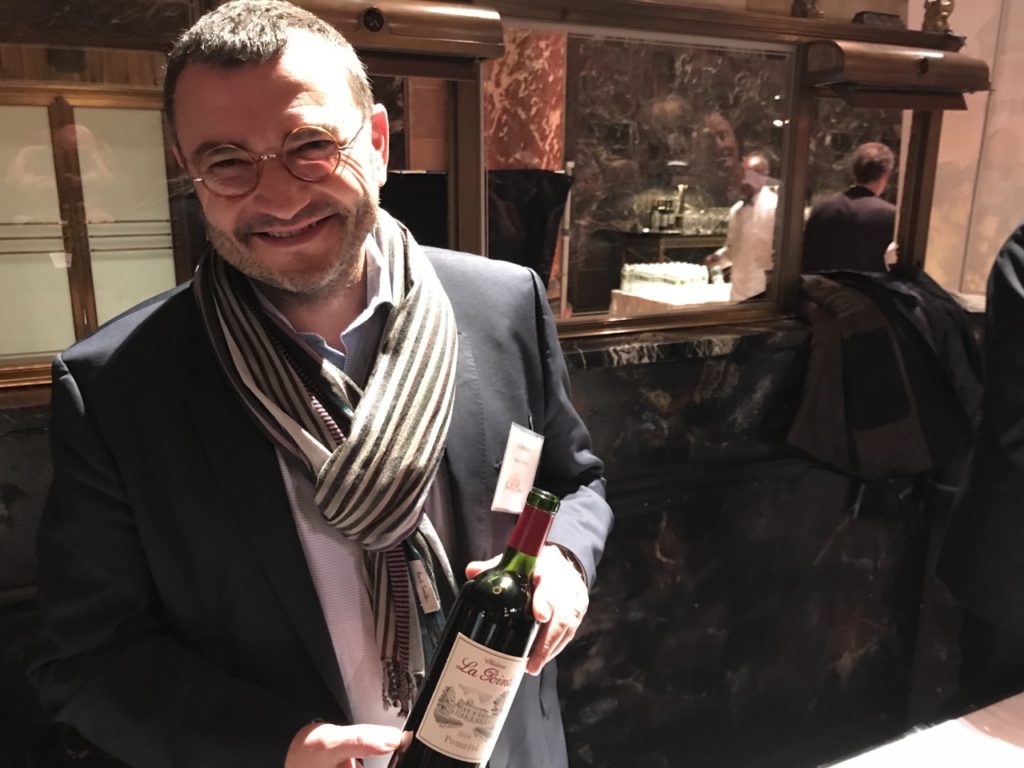
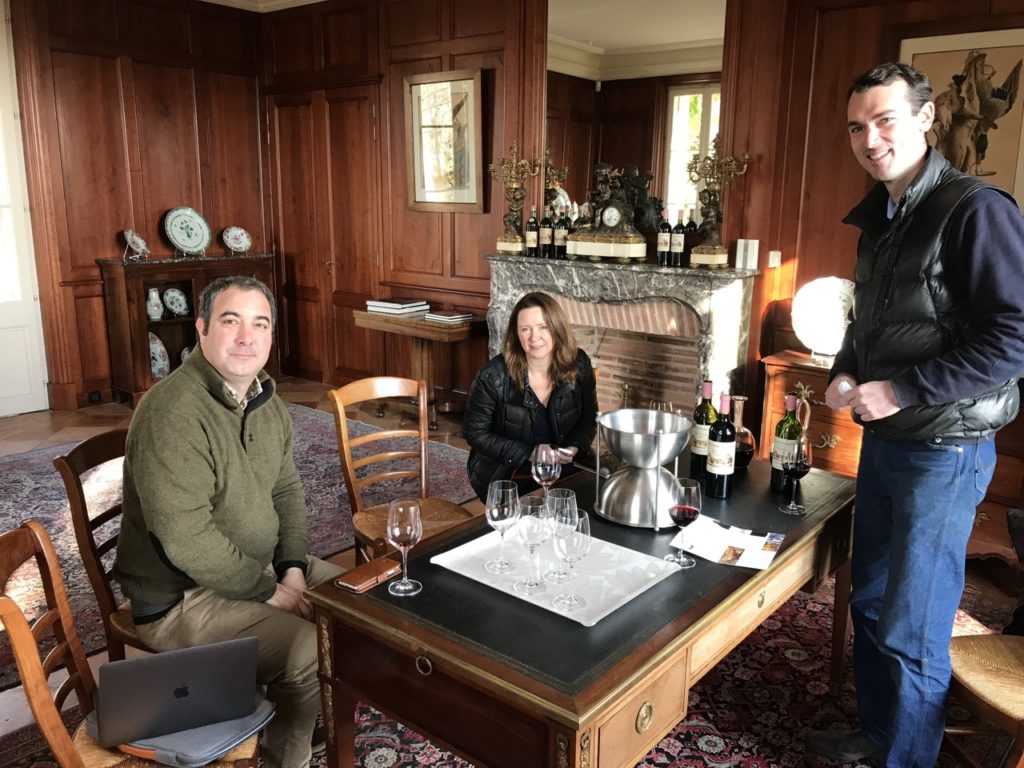
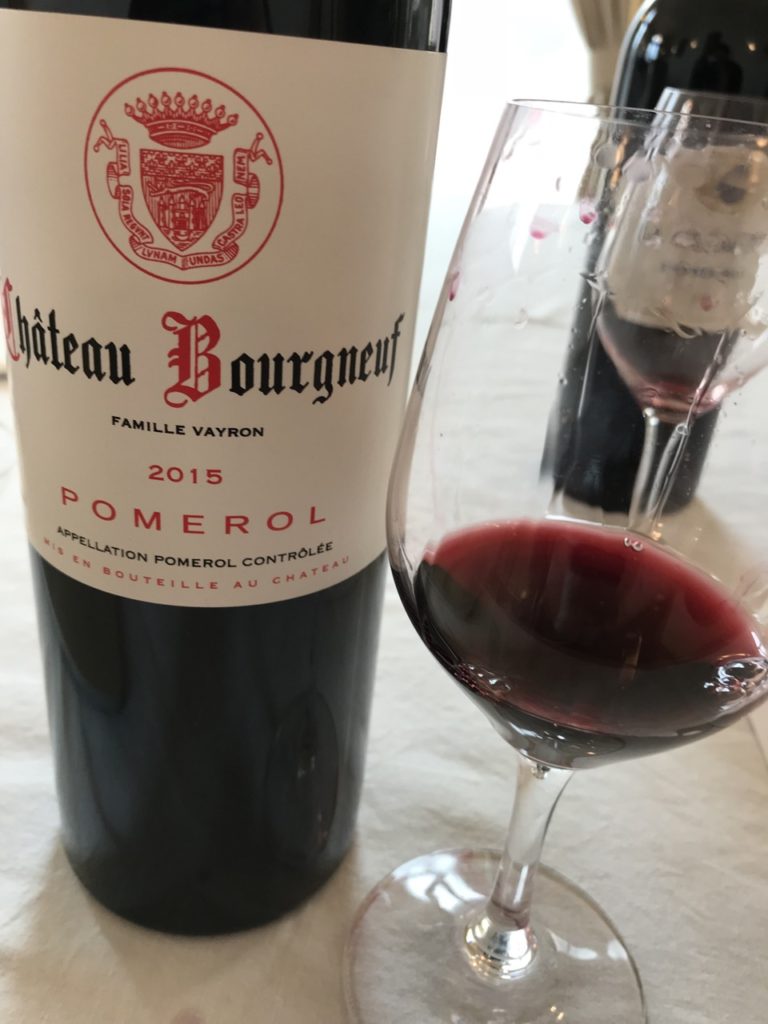
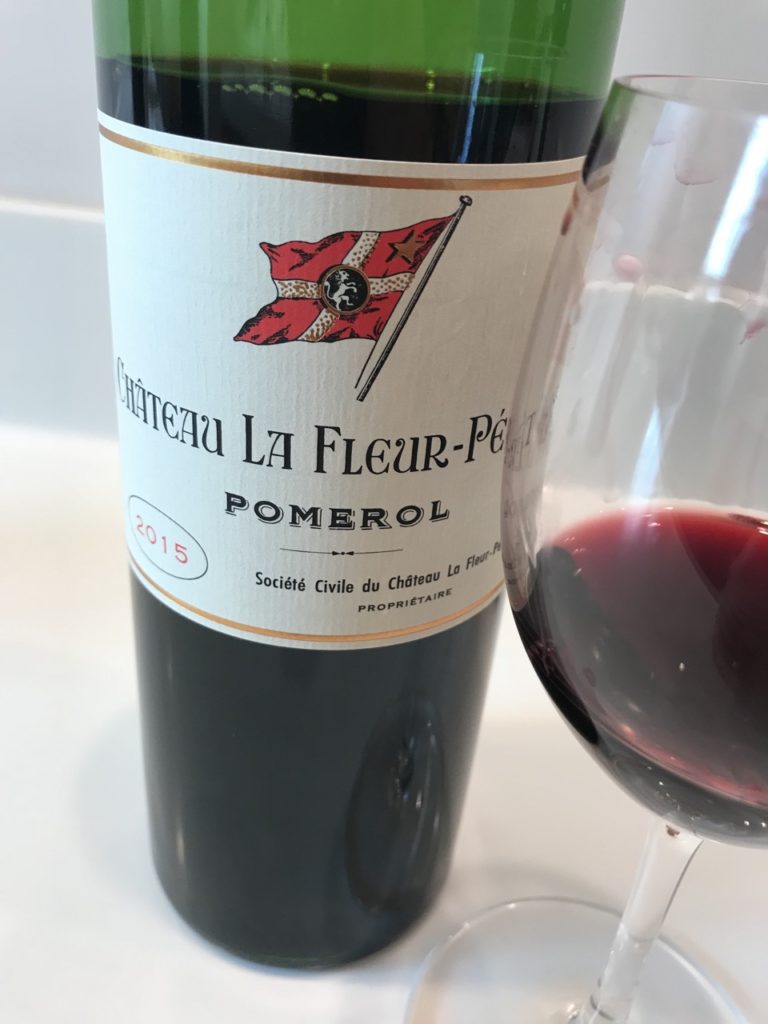
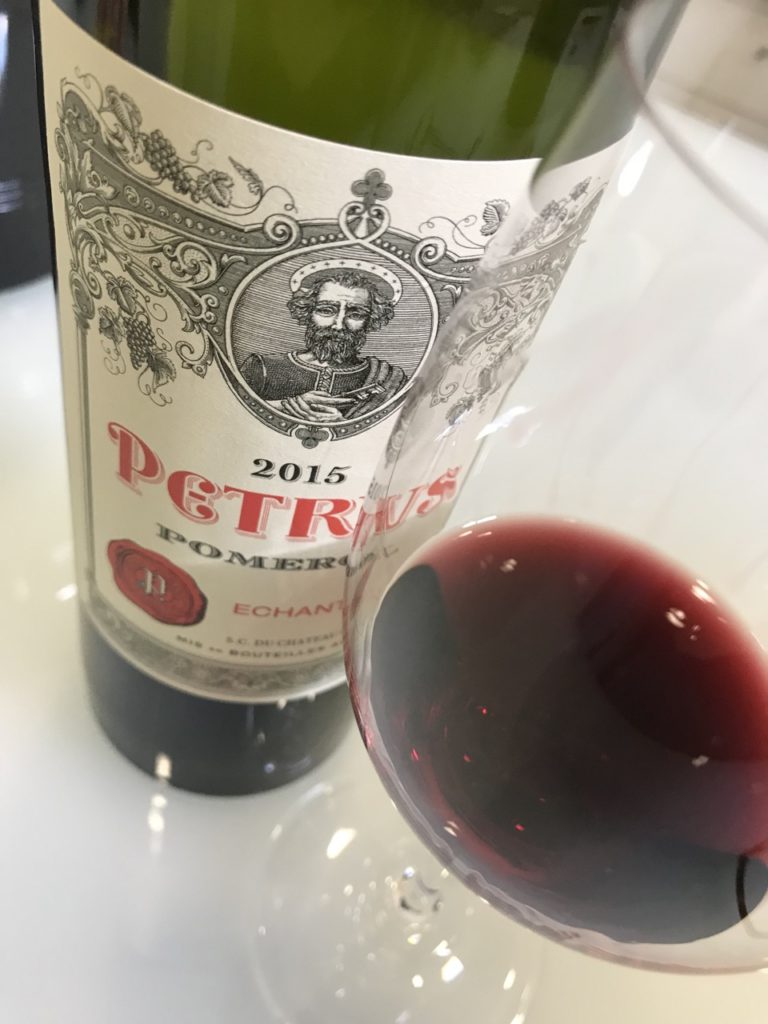

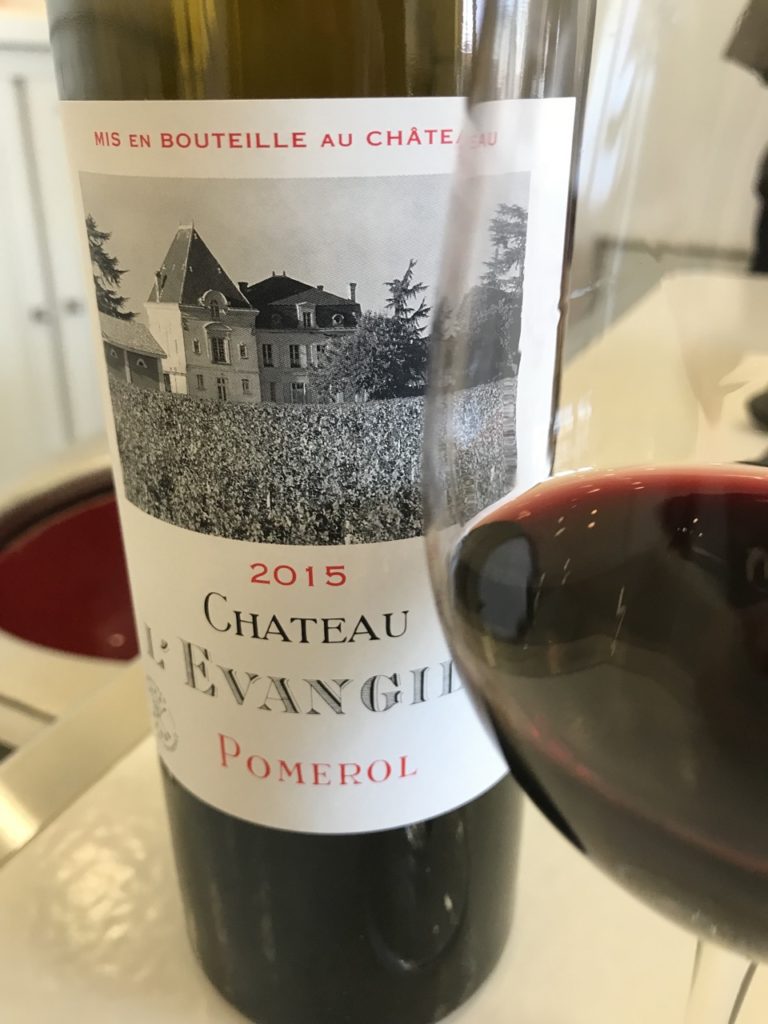

What about Petit Village 2015, L’Eglise Clinet 2015, Clinet 2015, La Cabanne 2015 and Clos L’Eglise 2015?